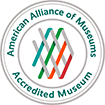Artifacts of a Patriarchy that Was and Wasn’t
LOS ANGELES — The Paternal Suit: Heirlooms from the F. Scott Hess Family Foundation, on view at the Long Beach Museum of Art, is an exhibition that examines the influence of flawed patriarchs and fathers on American history and American families. F. Scott Hess, the impresario whose poisoned family tree is rooted in this minefield of questionable Americana, plays the role of an American Joseph Beuys: an artist/critic who re-fashions cultural relics to mythologize his own life, excoriate patriarchy, and invent alternate histories.
The trove of over 100 photos, paintings, objects, and ephemera on display in The Paternal Suit — authentic items, fakes, and a few crafty hybrids — tells the embroidered and fantasized story of Hess’ forebears, and weaves their stories into the broader fabric of American history over a nearly 400-year span. It is a deeply ambivalent display that both broadcasts the artist’s acknowledgment of America’s past sins, and the role his family played in them, while also acknowledging that he very much wants to locate and assume his own place in this compromised lineage. It’s a complicated show that ultimately implicates everyone and everything, but one that also entertains with healthy doses of absurd humor.
Despite its deadpan press release and blandly expository wall tags, only children or the very densest of visitors will fail to feel the sense of discomfort that grows as the show’s fictions and realities separate over time. The ‘real’ elements and events of the show, if you can decide what they are, can’t easily be laughed off: the Salem Witch Trials, for instance, weren’t very funny. The Paternal Suit reminds you that your personal history can often be interwoven into this mess. Taken seriously, The Paternal Suit asks us all to relive some of the more sinister revelations of the American past and to gradually open up some of the tough emotions that they necessarily evoke.
In fact, the emotions that Hess has contrived to put museum visitors through are the same ones he has been feeling ever since his father drove off down the street, abandoning seven-year-old Scott, and also his mother and sister. Fathers and patriarchs, as Scott was forced to realize early, are necessarily hypocrites who build a patchwork world crafted from the lies and realities that support their own selfish needs. As Hess writes in the exhibition catalogue:
“The divorce and my subsequent abandonment by the ‘father,’ gave me a permanent distrust of all paternal authority figures, from policemen, politicians, and teachers to ministers, prophets, and, ultimately, God.”
As an adult, Hess doesn’t see a fine line dividing history’s winners and losers: he sees flawed men everywhere, covering their patriarchal asses generation after generation.
In some respects The Paternal Suit is his personal house of mirrors, and Hess takes a certain interest — and even a kind of sadistic glee — in observing the ability of visitors to the show to discern any nuggets of truth that glisten in the bull manure of mock seriousness that he has served up. In other words, anyone who doesn’t wake up to the show’s falsehoods is still a seven-year-old child, like he once was.
“When they are in the museum,” Hess notes, “people are called upon to make decisions about the truth of what they are seeing. They can’t tell what is true and what isn’t. How people react says a lot about them. Some laugh. Some are confounded. Some seem to understand. Some are angry. Some are inspired. Shouldn’t people go through life trying to figure out what is real and what isn’t?”
One of the most interesting aspects of The Paternal Suit is that Hess uses his considerable skills as an artist and narrator to tease his viewers into employing all their powers of discernment. Unlike most artists currently commenting on political and historical issues, Hess has chosen to reconstruct what other artists might deconstruct: it is the viewer’s job to break it all back down.
As Hess explains in a catalogue entry, the genesis of The Paternal Suit occurred when he finally reconnected with his biological father 32 years after the man’s departure.
Connecting with his father offered some psychological closure and also stimulated Hess’ interest in genealogical research. Five years later a Matthew Brady photo that arrived in the mail led Hess to the “Iverson line” of his family which included two slave-owning Southerners with strong Confederate ties: Senator Alfred Iverson Sr. (1798–1873) and his son, General Alfred Iverson Jr. (1829–1911). Iverson Sr., as it turned out, is mainly known for a defiant speech he made arguing for the continuance of slavery, and his son was a military failure who was removed from duty by Confederate General Robert E. Lee after his incompetent leadership of an infantry assault against Union forces on the opening day of the battle of Gettysburg. As Hess learned more about this side of his ancestry, he was both appalled and fascinated. His imagination and inventiveness were both challenged.
“While I was really energized in discovering their horrible acts, I was also often moved by their individual human stories. The Senator was quite an asshole, but reading his Senate speeches was as delightful as it was appalling, and he was reportedly an extremely sociable Southern gentleman. The General, Alfred Iverson Jr., CSA, bears one of the worst military records in the Civil War, yet he was in all the great battles until Gettysburg, then faced off against Sherman for his entire March to the Sea. He is my favorite character in this whole tree. What a spectacular life even though he was an utter failure in his chosen profession.”
One of the most notable and obviously spurious artifacts of The Paternal Suit is a twice life-sized Confederate Army jacket that comes with a carefully detailed provenance. As the story goes, General Iverson moved to Florida in the 1870s to become an orange grower, and the members of a local Confederate veteran’s group eventually named their lodge after him. Iverson’s jacket eventually ended up stored in the rafters of a “bull barn” where it was exposed over time to a combination of humidity, heat, and a unique “lysozmic gas” produced by Brahma bull excrement that caused it to swell to over twice its original size. The jacket — in all its ridiculousness — is at the lying heart of The Paternal Suit and gives the show its metaphor. Myth, swollen by bullshit, is an essential element of what we call history.
By the time they have seen General Iverson’s jacket most adult visitors are “on” to what Hess is doing and are reading the exhibition labels with smiles on their faces. The show increasingly offers a chance to admire Hess’ sheer inventiveness, although it still isn’t exactly a one-man show. Numerous “real” items and objects are peppered in along with the Hessian fakes. There are also fictional narratives that connect Hess ancestors to the “real” artist,Gutzon Borglum (1867–1941), the sculptor of Mount Rushmore. “Can you believe his name,” Hess comments, “I couldn’t have made that up.” What Hess may or may not have made up is Borglum’s membership in the Ku Klux Klan. There is some discussion of this on Borglum’s Wikipedia page, but as Hess reminded me after I accessed the Wikipedia page for Alfred Iverson Sr., Wikipedia is a great place to construct and disseminate falsehoods.
Works by fictional painters, whose works often inevitably look a bit like paintings by F. Scott Hess, are everywhere in The Paternal Suit: for example, there is an epic 1876 “Mural of Disaster” depicting the slaughter of General Iverson’s regiments by a “Plato Hawley.” There were apparently a number of painters in the “Patton Line” of Hess’ family, most notably Calvin Lemuel Hoole (1811–1863), a self-taught painter from Missouri who “died from wounds sustained in the Battle of Pea Ridge.” Calvin’s favored second son (1833–1906) was also an artist — his painting of General Stoneman’s horse appears in The Paternal Suit — who later became a producer of musicals who liked to dress in women’s clothing.
Then there are the charming “works” by Naomi Washington (1896–1951), a fictional African-American artist whose fictional grandparents were tragically owned by Scott’s real great-great grandfather. As I looked over a display of hand-painted “Naomi Washington” plates during the opening night of The Paternal Suit, I learned that the show also involves collaboration: a group of Hess’ artist friends stood near the plates discussing who had painted each one.
In its current form The Paternal Suit begins with the arrival of some Puritanical Iverson ancestors in Massachusetts in 1634 and ends with photos and paintings of Scott and his family members. One very touching and quite credible painting is a double portrait of Scott’s mother Katherine and his stepfather, Charles “Chuck” Hess, who legally adopted Scott and his sister in 1968. Chuck is there to represent the figure of a real patriarch: he was the father who stepped into Scott’s life and provided stability and warmth after another man walked away.
There are also portraits of Hess’ daughters and some paintings and relics that tell the story of his wife Gita’s Persian family and forebears. The increasing familiarity and apparent reality of the people who in appear in the show’s final rooms make a good point: people who love, surround, and shelter you are the ones you have the best chance of gaining a sense of the truth from. As for Scott’s earlier ancestors portrayed in the show — and the raft of objects and documents that he has surrounded them with to provide context — it is another situation entirely. Scott reflects on it all this way:
They were dead when I was born. Is the Library of Congress telling me the truth? I take it on faith they are. People believe in a lot dumber stuff than what you find in The Paternal Suit. I won’t even go there because it would piss so many people off. We all have our dumb beliefs, void of reason. We live our lives by them.
The Paternal Suit: Heirlooms from the F. Scott Hess Family Foundation is one view at the Long Beach Museum of Art (2300 East Ocean Boulevard, Long Beach, California) through October 5.
Seed, John. [2014, August 6] Artifacts of a Patriarchy that Was and Wasn’t. Retrieved from Hypoallergenic. http://hyperallergic.com/142288/artifacts-of-a-patriarchy-that-was-and-wasnt/


